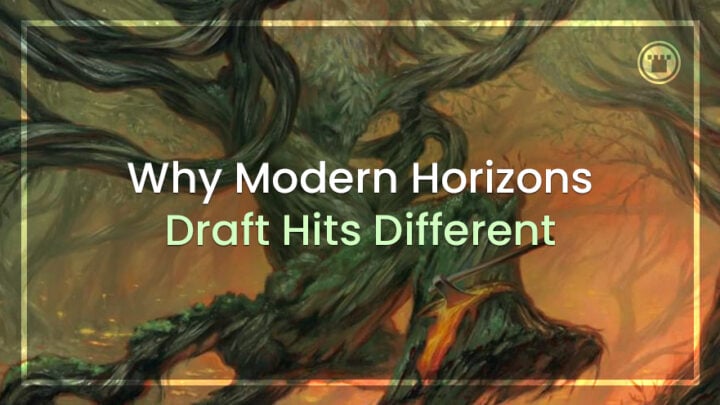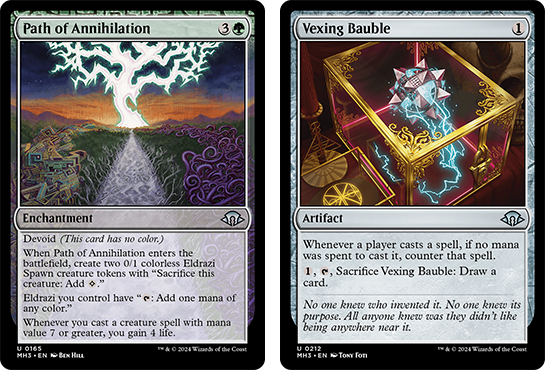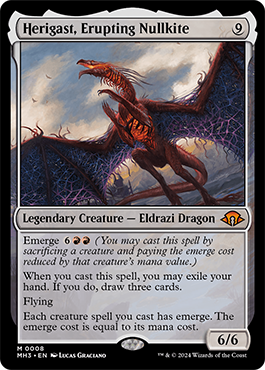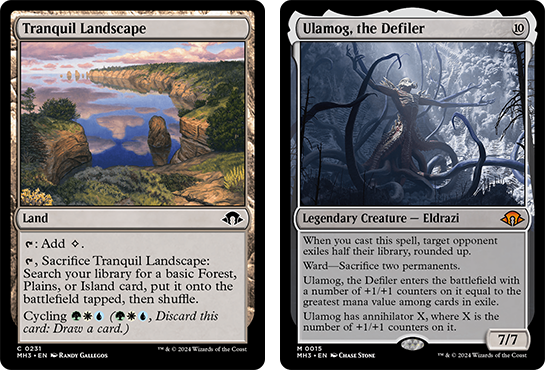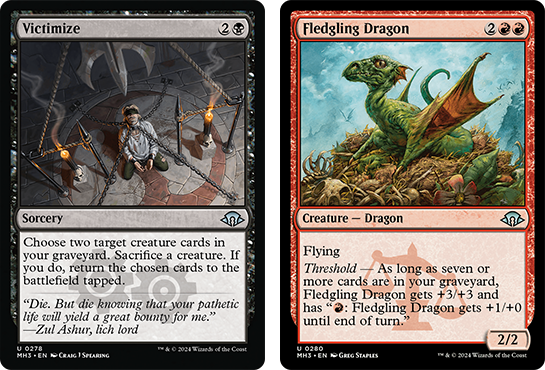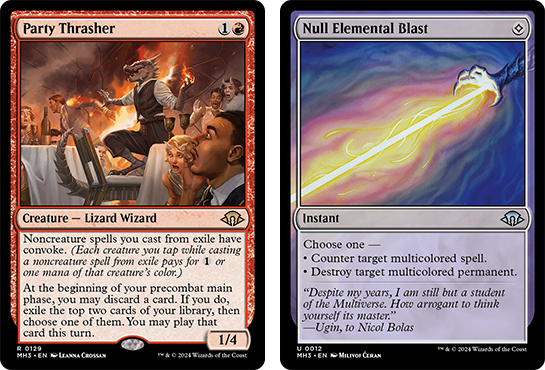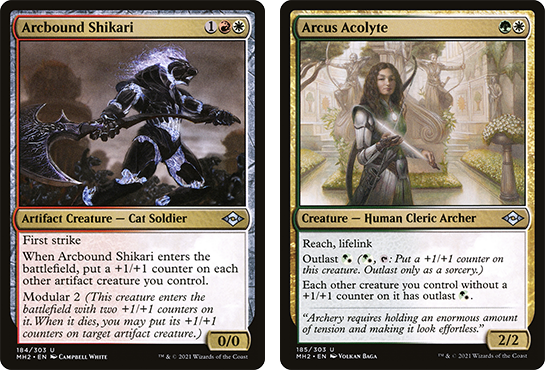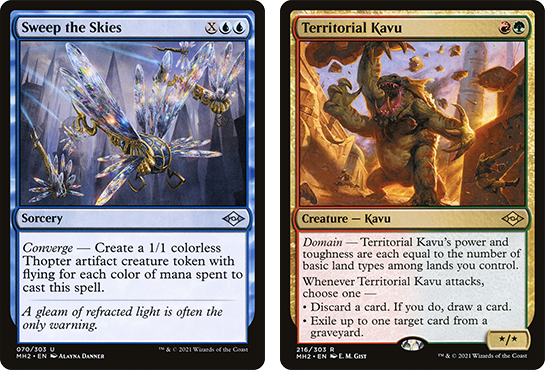Modern Horizons 3 boosters are about to hit shelves, chock full of electrifying new chase rares that are poised to shake up every format where they’re legal. They’re also draftable! And since this is going to be the first Modern Horizons set to get a full MTGArena release, it’s guaranteed to give many players their first taste of the unique Horizons-set draft environment.
Yep, even if you’re a veteran of regular draft formats – even if you’ve drafted your share of supplemental sets like Commander Legends: Battle for Baldur’s Gate or Lord of the Rings: Tales of Middle-earth – there’s little that can prepare you for a set this powerful and volatile.
So while we wait for the full release (and full draft guide!) why not remind ourselves what puts these draft formats in a class almost their own, and how you might best approach your first picks of Modern Horizons 3.
I’M SEEING SPIRALS
The power level of Modern Horizons sets doesn’t make them unique on its own, but it certainly makes a first impression! There are no obviously bad cards here anywhere, and it can be dizzying for players who are used to skimming over half the cards in each pack. Should you take a mythic rare flip-walker over that Amped Raptor? Is it better to prioritize a versatile removal spell, or a tricky build-around like Necrodominance? How many colors can you support in a set with fetches, Landscapes and dual-color MDFCs? Is that 10-mana Ulamog really castable??
That dizziness isn’t helped one bit by the sheer amount of card text. Even the lower rarity cards like Unstable Amulet sport intricate play patterns and finely-tuned text which will punish anyone who only half-reads them before sleeving up. Even the cards which make clear reference to the staples of yesteryear – and there are a LOT of those in MH3 – are just as likely to subvert the original effect in some powered-up twist as they are to mimic its effects!
Nethergoyf does not see card types in your opponent’s graveyard as Tarmogoyf once did. Hunted Wumpus and even Shivan Wumpus had negative triggers on ETB, but Wumpus Aberration only has a downside when cast. Birthing Ritual is definitely not Pod: you can only “upgrade” into a creature card from among the top seven of your library, but at least you’re now allowed to sidegrade or even downgrade in mana value instead.
Maybe you’re rolling your eyes here and saying “well yeah, obviously – I just read the cards”. But virtually every spell in MH3 is tricky in its own ways, and all the usual context clues we reflexively use to validate our first-glance understanding of cards are unreliable. The associations between flavor and mechanics, between complexity and power level, the understanding that narrow support cards are present to boost a relevant archetype… all of it is going to generate mixed signals the first few times you crack an MH3 pack.
In some ways Horizons sets feel like Cube Draft more than they do the average Limited environment. But even the more arcane and complicated Cube designs are built from pre-existing cards, with some chance of familiarity. Modern Horizons 3 barely offers a whiff of such mercy, its handful of true reprints vanishing into the hubbub of remixed and revisited designs.
Perhaps then it’s Time Spiral block which makes the best point of comparison. While not as powerful even in its own time, TSP/PLC/FUT might be the only other time drafters were presented with such arcane, Melvin-esque card designs across the board – or with such an insane kaleidoscope of mechanics!
There are even some very direct parallels to draw. Like Modern Horizons 2, Time Spiral uses a large helping of madness and flashback cards to offset the downside of various discard-based mechanics. Whether it’s activating spellshapers, paying flashback on Conflagrate, or just the side-effects of Pyromancer’s Swath, all of these discard mechanics would be varyingly playable in their own right, but combining them with the graveyard payoffs led to a competitive archetype.
Likewise, the various sacrifice and self-bounce costs in the format were at their best alongside echo creatures such as Firemaw Kavu, Timbermare and Stingscourger. Alternatively in a more blue-heavy draft they could be used to reset powerful morph triggers like Fathom Seer and Brine Elemental.
If RB Madness sounds like a relatively familiar theme, UWR self-bounce certainly does not! Modern Horizons sets have lived up to this with such oddities as UG self-mill control, and the “oops all game objects!” artifact token deck from MH2. It’s this willingness to unsettle our instinctive perceptions of value and build gameplans out of loosely-interchangeable mechanics which will seriously challenge Modern Horizons 3 drafters, even if they faithfully follow every line of rules text.
HOPE YOU LIKE KEYWORD SOUP
While Horizons sets do not introduce new game mechanics, they have a knack for transplanting modest abilities into unrecognizable contexts and combinations. Factor in the sheer number of similar keywords and effects being used in the same set, or even the same card if the designers get excited, and it can set you up for yet more wrongfooted assumptions about how cards will interact. At least they usually give you reminder text where applicable, so you don’t have to try and remember whether convoke can pay for Eldrazi spells that cost colorless mana (it can’t).
But I’ve already made enough hay about the extra attention demanded when parsing the cards. What gets really complicated in your first few Horizons drafts is trying to contextualize those cards into recognisable, operable Draft archetypes!
Despite strong fixing and multicolor support, the first two Modern Horizons formats still intended the average drafter to be in two base colors. It’s just that the boundaries between those two-color decks tended to be much more… nebulous than usual. Modern Horizons 2 in particular seemed to expect one if not two secondary colors unified by mechanical overlaps, like the modular keyword combining artifact (UWR) and +1/+1 counter (WGR) aggro themes.
Of course there’s no blanket statements in such a tricky environment – Modern Horizons 2 also had enough support for full five-color decks that drafters were constantly tempted to pivot to playing the “domain” archetype if their pack one had more fixing than gas!
Having a mental map of where you can make those mid-draft shifts between different decks is extremely valuable, given how relatively loose the archetypes in Horizons sets can be. Compared to the average formats, more of your power is going to come from efficiently harnessing the potential within individual cards than assembling a puzzle from synergistic pieces.
In practice, this means to keep an open mind about which parts of cards are important while reading them – and especially to try and consider non-standard ways to combine mechanics where value might be realized. If that seems like too much pressure for the first few runs of an admittedly dizzying draft set: just try to understand the points of general overlap between your 3 or 4 colors, and consider how potential picks play into that rather than any single focus mechanic.
LIMITED TIME TO ADAPT
There’s a lot more still to talk about when it comes to Modern Horizons 3 specifically, and we’ll get into all of that in the official Card Kingdom Draft Guide. But as I hope this article has conveyed, Draft sets like this have too much going on to fully dissect in just one week!
There’s no clever way to get around the overwhelming weight of new cards every player will have to digest. But the general experience of drafting these sets is something we DO have data on by now. If you want to take your preparation further than spoilers and get into the MH3 mindset, why not look up the kind of strategies and cards which were breakouts in its predecessors.
Modern Horizons 3 is here, and with it one of the more powerful Draft formats to come in a single set! Tom breaks down what makes it special.

Tom’s fate was sealed in 7th grade when his friend lent him a pile of commons to play Magic. He quickly picked up Boros and Orzhov decks in Ravnica block and has remained a staunch white magician ever since. A fan of all Constructed formats, he enjoys studying the history of the tournament meta. He specializes in midrange decks, especially Death & Taxes and Martyr Proc. One day, he swears he will win an MCQ with Evershrike. Ask him how at @AWanderingBard, or watch him stream Magic at twitch.tv/TheWanderingBard.

